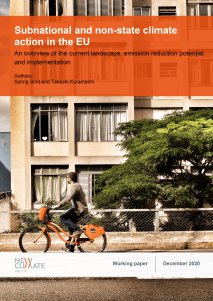Subnational and non-state climate action in the EU
NewClimate Institute
Checking in on subnational and non-state climate action in the European Union
With a significant amount of multi-level climate action taking place in Europe, the recent NewClimate working paper scrutinises subnational and non-state climate action in the European Union. The report analyses (I) the European landscape of subnational climate action, (II) the interactions between the EU and subnational and non-state actors, (III) the potential GHG emission reductions resulting thereof and (IV) the current progress towards their targets and objectives.
The landscape analysis shows that around 40% of the EU’s GHG emissions are covered by commitments from subnational and non-state actors. The number of cities, regions and companies which pledge net-zero emission targets have been steadily growing and now cover 36% of the EU’s total population (See also: NewClimate report on subnational net-zero pledges).
Subnational and non-state actors can thus make significant contributions to the EU’s emission reduction objectives. For that, an enhanced collaboration and coordination between the subnational, national and supranational level is vital, as the report points out.
Albeit there is limited information on the progress of subnational and non-state climate actors towards their goals, individual reports of cities show that considerable progress has been made in achieving their 2020 targets.
The report concludes that subnational and non-state actor can substantially contribute to EU-wide climate action, not only by implementing the EU’s targets but also by leading the way in setting higher ambitions.


